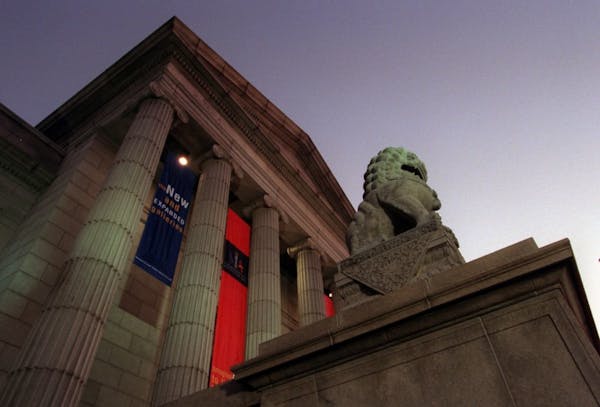"Jade Mountain Illustrating the Gathering of Poets at the Lan T'ing Pavilion" (1784): Commissioned by the Chinese emperor, this is considered the largest piece of historic carved jade outside China. More than 3 feet long the mountain was once owned by Minneapolis lumber baron T. B. Walker who kept it on his dining room table.
"The Doryphoros" (120-50 B.C.): One of four surviving Roman copies of a bronze sculpture by the legendary Greek artist Polykleitos, this handsome 6½-feet-tall statue represents an idealized athlete who would originally have been holding a spear in his missing left hand. Its name means "Spear Bearer."
"Corinthian Helmet" (circa 540 B.C.): In battle, this startlingly modern-looking 2,500-year-old bronze Greek helmet would have sported a horsehair crest.
"Shrine head" (12th-14th century): Made about 200 years before Leonardo da Vinci painted "Mona Lisa," this portrait was sculpted from clay in Ife, a royal West African city in what is now Nigeria. Acquired in 1995, the sculpture is one of only three such shrine heads in American museum collections.
"Memorial Head" (1550-1650): Made of bronze in the West African kingdom of Benin, in what is now Nigeria, this sculpture honors a deceased king or "oba," depicted wearing a beaded necklace and hat made of Mediterranean coral, evidence of his extensive power.
Jamie Okuma, "Adaptation II" (2012): Drawing on her Luiseño/Shoshone Bannock heritage, Okuma used traditional beading and quill work to decorate Christian Louboutin stiletto heels in contemporary American Indian style.
"Half armor" (1570-1580): Renaissance-era steel armor was so cumbersome, infantry soldiers left their legs bare so they could move faster. This ornately etched set was made in northern Italy.
"Adam and Eve," Albrecht Durer (1504): Though representing the biblical First Couple, the bodies of these figures are inspired by antique sculptures of Apollo and Venus. In this engraving the German artist depicted Eden as a dark, northern European forest populated with a rabbit, mouse and snake.
"Lucretia," Rembrandt van Rijn (1666): One of Rembrandt's most famous paintings, it depicts a Roman nobleman's virtuous wife who commits suicide to preserve her honor after being raped by the son of a tyrant.
"Astronomical Mantel Timepiece," Jean-Antoine Lepine (1789): The clockmaker to Louis XVI made this dazzling timepiece four years before the king was beheaded in the French revolution. The dials show the time in Paris and 12 other cities around the world. The decorations refer to Apollo, the god of the sun, music and poetry who was often associated with the French ruler. Lepine made a similar clock for the Prince of Wales; it's now at Buckingham Palace in London.
"Ganymede and the Eagle," Bertel Thorvaldsen (1817-29): The Danish sculptor spent 12 years in Rome making this sculpture for the London townhouse of an English nobleman. It depicts an ancient Trojan prince offering a drink to Zeus, disguised as an eagle.
"The Carpet Merchant," Jean-Léon Gérome (1887): The French artist depicts merchants and potential buyers admiring a splendid rug in a Cairo market he visited.
"Olive Trees," Vincent van Gogh (1889): Painted less than a year before his suicide, this is one of 15 pictures that the Dutch artist made of an olive grove in St.-Rémy, France.
"Templeman teapot," Paul Revere (1792-93): When he wasn't warning American rebels that "The British are coming!" Revere was one of colonial Boston's most talented silversmiths. He made this elegant silver teapot as part of an elaborate service commissioned by John Templeman.
"Study for Improvisation V," Wassily Kandinsky (1910): Though superficially abstract, this expressive Russian painting depicts a scene from the Apocalypse in which a blue-robed woman kneels before a tall, red-clad and blue-faced figure with streaming golden hair who may represent Jesus. Behind them, two men on horseback leap a fence.
"Aphrodisiac Telephone," Salvador Dali (1938): The Spanish surrealist added a "lobster" handpiece to a standard phone base to create this phone, which actually worked.
"Marilyn Monroe, actress," Richard Avedon (1957): Always interested in revealing expressions, Avedon captured the American sexpot in a poignantly lonely moment.
"Flower Vendors," Alfredo Ramos Martinez (circa 1935-38): The graceful flower-sellers in Martinez' drawing walk in a line reminiscent of ancient Egyptian figures.
"Factory Workers," Romare Bearden (1942): Commissioned for Fortune magazine, this stylized drawing accompanied a 1942 story about the social and economic costs of racial discrimination.
"Tatra T87," Hans Ledwinka (designed 1936, made 1948): This aerodynamic sedan is one of the most famous designs by Austrian auto engineer Ledwinka, who registered more than 1,000 design patents.
"Forest Coat," Jon Eric Riis (2005): Made of silk, metallic thread, beads and sequins, this dramatic tapestry-sculpture was commissioned from the American designer by the museum. Baroque leaf designs on the outside open to gigantic worms and insects inside.
"Cagney," Andy Warhol (1963): Appropriated from the 1931 movie "The Public Enemy," this screen print shows movie star James Cagney playing a thuggish killer.
"Folding Roundback Chair" (late 1500s): One of the finest examples of a chair often used by Chinese emperors as a portable throne. Made of now extinct Huang-hua-li wood, it has unusual iron fittings decorated with lotus designs in silver inlay. Museum benefactor Bruce Dayton paid $453,000, then a world record, for it in 1996. Ignoring "keep off" signs, a museum visitor stepped over a barricade, sat on it and broke it in 2001. Repairs cost nearly $10,000.
"The Birthplace of Herbert Hoover, West Branch, Iowa," Grant Wood (1931): Iowa businessmen hired the Iowa artist to depict the U.S. president's childhood home but Hoover rejected the picture because he thought the two-story house at the center of the painting obscured the little white cabin behind it where he was actually born.
"Your Dog," Yoshitomo Nara (2002): Capitalizing on the universal popularity of winsome cartoon pets, the Japanese sculptor makes gallery-sized versions of this adorable pooch. This sculpture was an immediate favorite with museum visitors of all ages.

Helen Simonson is in Jane Austen mode with 'The Hazelbourne Ladies Motorcycle and Flying Club'
New Orleans' own PJ Morton returns home to Jazz Fest with new music

Biden awards the Medal of Freedom to Nancy Pelosi, Medgar Evers, Michelle Yeoh and 15 others

